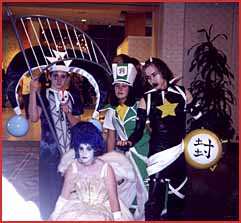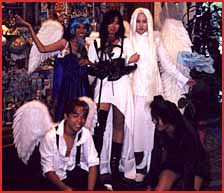|
At the same convention David Ramsay, a professional costumer who sells custom made costumes of anime characters through his Cosplay Closet website- and who, along with his wife Kimberly, often judges the costume contests- lectured a group of avid cosplayers on proper handling of props, transportation and care of costumes, and the protocols of posing for photos in order to best show off the lines of a costume. If the audience at the masquerade party that night was paying attention to such details as they hooted madly for Maya to win a mock dance contest, and roared at a somewhat clumsily staged kung-fu battle/strip tease, they hid it well. But to the cosplayers themselves such details definitely matter. Gina Jaio of Sailor Jamboree summed up the sentiments of many cosplayers. "It's the ones who go all out, who go all the way for every detail, that we get excited about," she explained. "It's like anime in real life." No event draws a larger or more excitable crowd than the Masquerade, a convention's official costume contest/talent show. John Cook, organizer of the Masquerade at Nan Desu Kon in Denver, described it as, "Pretty much the headlining event." At Anime Expo 2000, tickets to the event were so in demand that thousands of anime fans, not typically known as morning people, lined up at eight a.m. that morning to score the sought-after ducat.
These costume galas feature the full range of cosplayers: amateur costume designers walking the stage like runway models displaying their handiwork; preteens in homemade dresses lip-synching Minmei songs; teenage guys enacting their favorite videogame fights; and more polished performers in flawless costumes who often perform whole scenes or sketches based on their favorite anime. Judges award prizes for costume quality- often in novice, journeyman and professional divisions- and for the best performances by groups and individuals. The Masquerade's stature among convention events affirms the importance of cosplay to the convention experience. Folklorist Camille Bacon-Smith describes cosplaying's importance to a convention in her book "Science Fiction Culture" (the third chapter is available on line at http://www.voicenet.com/~camille/rituals.html). Writing about the Masquerade at the science fiction convention WorldCon in the seventies she explained, "Fans use dress and costume like ritual garb to establish space and time as particular to the social functioning of the group, to train new members in the conventions of the community, and to reinforce a sense of identity among the established members." Convention lovers without PhDs acknowledge the ritual function of cosplay more abstractly. Tomasch offers, "They put the feel into the con." Or as Jaio puts it, "When you walk into a hotel, it doesn't feel like a con until you hit the people in costumes." That feel is every con-goers cue that they may stop behaving normally and let out their inner otaku (even if they actually only dabble in dub v. sub gang warfare, and have no more knowledge of home electronics than how to spell DVD). Literal recognition of the cosplayers manifests each con-goer's recognition of the world within the con as particular to a unique community with its own shared interests and values. By participating, whether costumed or not, in the ritual of cosplay, the con-goers demonstrate their acceptance of those shared interests and values, and thus acknowledge themselves to be a member of the community defined by them. This acknowledgement, and the acceptance of other community members' interests and feelings that it implies, is necessary for any group with significant diversity of tastes, opinions, backgrounds and other interests to unite themselves as a community. Bacon-Smith elaborates: "The convention is a performative event in which a conceptual community tied together by long distance communication, mass market publication, and occasional face to face meetings is physically played out for the benefit of the players . . . Fans need costume, especially the masquerade, to provide that inclusive sense of unity that draws the new member and long-time fan together in the same community." Cosplaying is popular and beloved at any convention because it's the only thing that the "Sailor Moon" devotees, the "Bebop" hepcats, and the "Dragonball Z" zanies can do with each other. Any 12-year-old "Sailor Moon" fan could have told me as much- if they didn't think I was such an imbecile.
|


